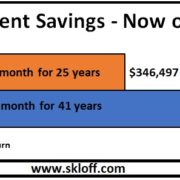Which Retirement Savings Plans? – Independent Press

The Independent Press
Money Matters – Skloff Financial Group Question of the Month – January 8, 2014
By Aaron Skloff, AIF, CFA, MBA
Q: Changes to our employers’ retirement plans are making saving for retirement more difficult. Which retirement savings vehicles should we consider using?
A: The Problem – Leaving Matters in the Hands of Your Employer. Many companies have discontinued offering pension plans to their employees. With so many states and municipalities financially stretched to the breaking point, even public school districts are considering the formerly unthinkable, discontinuing their pension plans.
The Solution – Taking Matters Into Your Own Hands. Many employers have substituted their pension plans (defined benefit plans) with 401(k), 403(b) and 457(b) plans (defined contribution plans). While contributions to pension plans are primarily made by the employer, contributions to these plans can be made by both you and your employer. Like pension plans, some of the greatest benefits of pension plans are the tax benefits — including pre-tax contributions and tax deferral of capital gains, dividends and interest inside plans. Take the time to understand what retirement plans your employer offers and embrace the plans.
Are You Interested in Learning More?
401(k) Plans. If your employer offers a 401(k) plan you can contribute up $16,500 per year or $22,000 if you are 50 years of age or older. Through a combination of your own contributions and contributions by your employer, total contributions can reach $49,000 or $54,500 if you are 50 years of age or older. Ask your employer if they offer a matching program. This equates to a 100% guaranteed return on your investments. Even if making contributions to your plan is a financial stretch a times, at the very least maximize your employer’s match.
403(b) Plans. If your employer offers a 403(b) plan your can contribute up $16,500 per year or $22,000 if you are 50 years of age or older. If your have 15 or more years of service with a qualified organization, you can also contribute up to $3,000 per year, up to a lifetime catch-up limit of $15,000 (based on the Lifetime Catch-up or “15-year rule”).
457(b) Plans. If your employer offers a 457(b) plan you can contribute up $16,500 per year or $22,000 if you are 50 years of age or older. If you did not contribute the maximum amount to a 457(b) plan or another Workplace Savings Plan subject to Workplace Savings Plan coordination rules, you may be able to contribute up to $33,000 for up to three years (based on the Double Limit Catch-Up or “Special Section 457(b) Catch-up”).
Fortunately, many public school districts offer both 403(b) and 457(b) plans. If you work for a qualifying employer you may be able to simultaneously maximize your contributions to 403(b) and 457(b) plans.
Individual Retirement Accounts. In addition to or in lieu of employer sponsored retirement plans you and your spouse can each contribute to an Individual Retirement Account (IRA) – even if your spouse does not earn a salary. You and your spouse can each contribute up to $5,000 per year or $6,000 for each person who is 50 years of age or older.
Action Steps: Don’t let changes by your employer determine your retirement security. Take matters into your own hands and save aggressively in your employer’s retirement plan and an IRA.
Aaron Skloff, Accredited Investment Fiduciary (AIF), Chartered Financial Analyst (CFA), Master of Business Administration (MBA) is CEO of Skloff Financial Group, a Registered Investment Advisory firm based in Berkeley Heights. He can be contacted at www.skloff.com or 908-464-3060.












